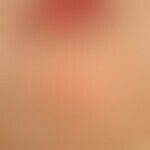Synonym(s)
DefinitionThis section has been translated automatically.
Worldwide, epidermal, highly infectious bacterial infection of the skin not bound to the skin appendages (hair follicles, sweat glands) caused by staphylococci (in 80% of cases Staphylococcus aureus is the sole trigger) and somewhat less frequently by streptococci (in 10% streptococci are the sole triggers) (note: an infection of the skin with pus-forming bacteria is also generally referred to as pyoderma ). The reservoir of germs is often the nasopharynx.
ClassificationThis section has been translated automatically.
A distinction is made between two forms:
- large blistered impetigo contagiosa (bullous impetigo or bullous impetigo)
- small blistered Impetigo contagiosa (non-bullous impetigo)
(this distinction no longer plays a role in daily work and is rather of historical significance, especially since no clinical decisions (e.g. type of pathogen, therapy) are associated with this morphological characterization).
You might also be interested in
EtiopathogenesisThis section has been translated automatically.
Occurring especially in children. Especially in the warm season. Transmission occurs by smear infection (contact directly via the skin or via contaminated objects). Thus, under poor hygienic conditions, small endemics can break out in close communities such as families or holiday camps.
A prerequisite for the development of staphylogenic impetigo are the exfoliatins A and B synthesized by certain Staphylococcus aureus strains. Serine proteases cleave the intercellular adhesion structures between keratinocytes in the stratum granulosum and in this way lead to blister formation. In rare cases of impetigo contagiosa with Staphylococcus aureus as the causative pathogen, toxinaemia and even the development of SSSS may occur in newborns due to the lack of immunity.
ManifestationThis section has been translated automatically.
Mostly seen in children and occurring in the warm season.
LocalizationThis section has been translated automatically.
Mostly face and hands, uncovered body regions. Not infrequently also infestation of the corners of the mouth(angulus infectiosus) or the trunk of the body. Rare infestation of the palms/soles of the feet, fingers/toes.
ClinicThis section has been translated automatically.
Most often onset after a minor trauma. Incubation period 2-10 days. Initially red 0.5-3.0 cm large itchy red spots. Later, on these erythemas shooting up of flaccid, but also tense vesicles and blisters with clear contents. Subsequently, rapid transformation into thin-walled, smaller and larger, also confluent pustules. After bursting of the pustules there is a strong exudation of purulent serous tissue fluid, which finally dries up with the formation of typical honey-yellow to brownish barky crusts (conventional name: bork lichen, smut lichen). Remark: Often the pustules remain unnoticed.
If left untreated, the nummular foci heal centrally, leaving anular, peripherally migrating formations.
Thus, above all, the clinical picture of infantile impetigo is not characterized by clearly visible pustules but by weeping, crusted, pruritic plaques.
The pyoderma is spread by autoinoculation, usually by the scratching fingernail.
On the palms and soles of the feet, pustules may persist for a long time, so that they may characterize the clinical picture in contrast to the infantile impetigo forms (see Fig.).
Non-bullous impetigo: Initially usually also vesicles, on presentation to the doctor usually only honey-yellow crusts. Also occurs as a superinfection of existing skin defects (impetiginisation), e.g. in atopic dermatitis, insect bites, herpes simplex or VZV infections.
DiagnosisThis section has been translated automatically.
Detection of the pathogens (strepto or staphylococci) by smear from a still intact bladder (pustule). Spread a thin layer of material on a microscope slide, air-dry, fix and stain using the Gram technique . Gram staining allows the detection of Gram-positive cocci in heaps or grapes. The pathogen culture is usually carried out on blood agar. The result can be read off after 24-48h (Hartman-Adams H et l. 2014). A further differentiation can be made by means of the coloured series (Api-Staph system, Api-20-Strep system).
Differential diagnosisThis section has been translated automatically.
Superinfected herpes simplex infection: Grouped arranged pruritic vesicles with clear contents; history of known recurrences in loco.
Tinea faciei: slow onset and slow progression; circular border of lesions; microscopic (and cultural) evidence of fungus.
Acute toxic dermatitis: sudden onset after contact event; vesicular dermatitis; sharp border, pruritus.
Complication(s)(associated diseasesThis section has been translated automatically.
otitis media
Acute poststreptococcal glomerulonephritis(PIGN): acute, immune-mediated, post-infectious inflammation of the renal glomerula, which mainly affects children between 5 and 15 years of age (Wang D et al. 2017).
TherapyThis section has been translated automatically.
Cover affected areas of skin with a gauze or with an adapted tubular bandage (to avoid the transmission of bacteria through the scratching finger). Do not use a plaster for fastening.
Crusts are best softened with ointments or soft pastes (e.g. 2% Clioquinol titanium oxide paste), if necessary with disinfectant solutions such as quinolinol solution (e.g. Chinosol 1:1000) or R042 or polihexanide (Serasept®, Prontoderm®). Instead of Clioquinol ointment, a 2% quinolinol ointment (alternatively: polyvidon iodine ointment such as Betaisodona®) or a disinfecting soft zinc paste (beneficial in case of infestation of intertriginous areas) can be chosen.
Local antibiotics have proven to be particularly effective, e.g. Infectopyoderm®, fusidic acid (e.g. Fucidine®), gentamicin (e.g. Refobacin® ointment). Pleuromutilin has proven to be a more recent antibiotic.
Change the dressing twice a day: Put on gloves, dab the flock with pure olive oil; gently remove crusts, open pustules and blisters with a cannula, treat again with ointments.
Disinfecting baths are beneficial for the healing process (e.g. with quinosol 1:1000, potassium permanganate (light pink) or polyvidon iodine solution).
Note(s)This section has been translated automatically.
The division into: large-bubble Impetigo contagiosa (bullous impetigo) and small-bubble Impetigo contagiosa (non-bullous impetigo) is not common in Anglo-American literature. There the classification is made according to "bullous impetigo" for the large-bladed impetigo conatiosa and "non-bullous" for the small-bladed impetigo contagiosa. This is justified insofar as bullous impetigo is rarely seen. Instead, flat, greasy crustal formations often impress.
LiteratureThis section has been translated automatically.
- Hartman-Adams H et l. (2014) Impetigo: diagnosis and treatment. Am Fam Physician 90:229-35.
- Mempel M et al (2015) Selected bacterial infections of the skin in childhood. Dermatologist 66: 252-257
- Rittenhouse S et al (2006) Selection of retapamulin, a novel pleuromutilin for topical use. Antimicrob Agents Chemother 50:3882-3885
- Wang D et al (2017) Acute postinfectious glomerulonephritis associated with scabies in the elderly: A case report. Parasitol Int 66:802-805.
Incoming links (32)
Acropustulosis of infancy; Blepharitis; Bubbles; Bulla repens; Candida folliculitis; Coriandri aetheroleum; Diphtheria, impetiginous; Folliculitis gramnegative; Fox's impetigo; Fox, william tilbury; ... Show allOutgoing links (13)
Clioquinol titanium oxide paste, soft; Fusidic acid; Gentamicin; Glomerulonephritis acute postinfectious; Gram staining; Impetigo contagiosa, large-bubble; Impetigo contagiosa, small vesicles; Perlèche (overview); Pleuromutilin; Pustule; ... Show allDisclaimer
Please ask your physician for a reliable diagnosis. This website is only meant as a reference.































